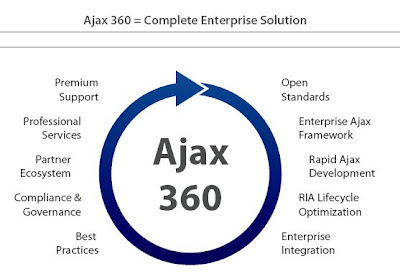Pauline Ratnasingam (2003) states that, in order achieve potential benefits of e-commerce, organization should follow characteristics of leaders that include being smaller and more focused on business benefits in e-commerce. Moreover, organizations should give e-commerce higher importance in their business strategies by having an aggressive cost focus and higher and more specific expectations from technology. Hence, organizations will be able to demonstrate higher levels of integration of e-commerce.
AJAX acts a loser within the enterprise software architecture.
According to a Backbase's research (Backbase, 2009). , it indicates that the top five problems hindering successful enterprise Ajax implementation are:
a.) Unsupported Ajax projects, widgets, and toolkits
There are many open source Ajax projects, but these solutions are fragmented and no software company is supporting them or committed to their future. These projects are developed differently, are incompatible with each other, and it’s a safe bet that the vast majority of them won’t exist two years from now. It’s very difficult to make a safe choice here. Even if a software company is backing the project, the level of commitment is very modest. They typically don’t provide business-grade support and training, and no guaranteed roadmap for ongoing development.
b.) Lack of established Ajax best practices
Because Ajax is a fairly new technology, few people know the proven best practices for Ajax development. Without best practices, businesses often face expensive trial-and-error exercises, unnecessary project delays, downstream code integrity and maintenance issues, and sometimes security threats. Getting it right can waste a lot of money and time.
c.) Poor integration of Ajax in the normal development lifecycle
Most Ajax tools available today are no more than loosely organized JavaScripts. They have no tools for rapid application development, accelerated testing and debugging, or integrating Ajax into existing application development processes and tools. Further, using these free tools proliferates “spaghetti code:” an unstructured hodgepodge of JavaScript code that makes application testing and maintenance a nightmare.
d.) Lack of reliable external support and trainingRisk of intellectual property violations
When technology isn’t supported by a commercial business, businesses need alternatives for training and supporting their development environment. Some consulting companies offer support on open source projects, but it’s not their core business and they typically deliver it as a “one-off.” Without the economies of scale, support services become expensive and unsustainable, leaving clients “high and dry.”
e.) Risk of intellectual property
Many open source Ajax projects include code from several sources on the Internet. These code snippets are licensed under different licenses with different terms of use. There is no guarantee that the code doesn’t violate patents. Developers are usually unaware of these risks; they simply use whatever code will speed up development. However, users of open source projects can be targets for patent infringement claims — especially as open source projects are hard to sue. Given these sizable problems, it's understandable that enterprises might hesitate to implement Ajax. However, with market momentum driving IT departments to deliver RIAs to customers and internal clients, avoidance isn't an answer. Enterprises need a reliable partner, whose core business is ongoing Ajax innovation, code maintenance and product support. That partner is Backbase. And the solution is Backbase Ajax 360.Backbase Ajax 360. Please refer to below figure which is from backbase. In the figure, we can find that Ajax 360 seem a complete enterprise solution.

References:
Pauline Ratnasingam (2003), Idea Group Inc (IGI), “Inter-organizational trust in business-to-business e-commerce”, pp.16-17.
Backbase (2009). “AJAX in enterprise whitepaper” . Received 24th March, 2009 from URL -
http://docs.backbase.com/docs/WP_Ajax_in_the_Enterprise.pdf

沒有留言:
發佈留言